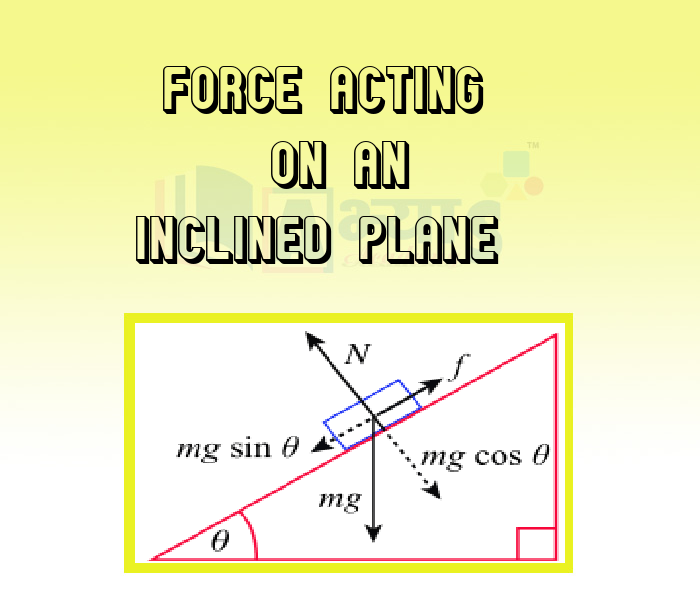Force Acting on an Inclined Plane










Force Acting on an Inclined Plane
The normal forces in an inclined plane are not always directed upward opposite to the direction of gravity but rather they are always directed perpendicular to the surface that the object is on. To understand the direction of the force acting on an inclined plane the force acting on the object will has to be resolved in two components.The force that is directed to an angle to the horizontal is resolved into horizontal and vertical components. This can be explained with the help of an example.
For example:
In the figure the object is moving down an inclined plane which is making an angle with the plane, with Force = f
.jpg)
The normal force = N and it is perpendicular to the plane
is the weight of the load.
The component that balances the Normal force
The component that is responsible for the sliding motion is
In the absence of the friction and the other forces, the acceleration of an object is the value of the parallel component divided by the mass.It results in the equation as
In the presence of the friction and other forces such as applied force and tensional force, it gets slightly complicated.
Q 1. A five kg mass, initially at rest, slide down a friction less incline.Calculate the force parallel to the incline and the acceleration of the mass . If the incline is 0.8 m long, calculate the velocity of the mass when it reaches the bottom of the incline.
Solution: We have to calculate force parallel to the incline , acceleration and the velocity of the mass
The force parallel to the incline ,
= (5)(9.8)(sin30) = 24.5 N downwards (sin 30 = 0.5)
Acceleration of the mass is , = (9.8)(sin 30) =
Velocity of the mass on reaching the bottom can be find out using equation
Here, u = 0 , a = and s = 0.8 m
So,
Q. A 2 kg mass is incline down an inclined plane with an unknown angle , as shown.The incline is assumed to be frictionless and is 1.2 m long. The mass start from the rest and is observed to take 2.3s to reach the bottom . What is the angle of incline?
Solution: A of the mass along the incline,
.....................(i)
We need to use this formula ,
.................(ii)
Now, from equation (i) and (ii)
Which of the following are correct : (a) The normal forces in an inclined plane are not always directed upward opposite to the direction of gravity (b) The normal forces in an inclined plane are always directed perpendicular to the surface that the object is on. (c) The force that is directed to an angle to the horizontal is resolved into horizontal and vertical components. | |||
| Right Option : D | |||
| View Explanation | |||
The normal forces in an inclined plane are always directed ___________________ to the surface that the object is on. | |||
| Right Option : B | |||
| View Explanation | |||
The force that is directed to an angle to the horizontal is resolved into ____________________components. | |||
| Right Option : C | |||
| View Explanation | |||
Students / Parents Reviews [20]
I have spent a wonderful time in Abhyas academy. It has made my reasoning more apt, English more stronger and Maths an interesting subject for me. It has given me a habbit of self studying

Yatharthi Sharma
10thAbhyas is a complete education Institute. Here extreme care is taken by teacher with the help of regular exam. Extra classes also conducted by the institute, if the student is weak.

Om Umang
10thMy experience with Abhyas academy is very good. I did not think that my every subject coming here will be so strong. The main thing is that the online tests had made me learn here more things.

Hiya Gupta
8thThe experience was nice. I studied here for three years and saw a tremendous change in myself. I started liking subjects like English and SST which earlier I ran from. Extra knowledge gave me confidence to overcome competitive exams. One of the best institutes for secondary education.

Aman Kumar Shrivastava
10thIt was good as the experience because as we had come here we had been improved in a such envirnment created here.Extra is taught which is beneficial for future.

Eshan Arora
8thWhen I have not joined Abhyas Academy, my skills of solving maths problems were not clear. But, after joining it, my skills have been developed and my concepts of science and SST are very well. I also came to know about other subjects such as vedic maths and reasoning.

Sharandeep Singh
7thA marvelous experience with Abhyas. I am glad to share that my ward has achieved more than enough at the Ambala ABHYAS centre. Years have passed on and more and more he has gained. May the centre flourish and develop day by day by the grace of God.

Archit Segal
7thAbhyas is an institute of high repute. Yogansh has taken admission last year. It creates abilities in child to prepare for competitive exams. Students are motivated by living prizes on basis of performance in Abhyas exams. He is satisfied with institute.

Yogansh Nyasi
7thAbhyas institute is one of the best coaching institute in the vicinity of Ambala Cantt area. The teachers of the institute are well experienced and very helpful in solving the problems of the students.The good thing of the institute is that it is providing extra classes for the students who are w...

Aman Kumar Shrivastava
10thOne of the best institutes to develope a child interest in studies.Provides SST and English knowledge also unlike other institutes. Teachers are co operative and friendly online tests andPPT develope practical knowledge also.

Aman Kumar Shrivastava
10thUsually we see institutes offering objective based learning which usually causes a lag behind in subjective examinations which is the pattern followed by schools. I think it is really a work of planning to make us students grab the advantages of modes of examination, Objective Subjective and Onli...

Anika Saxena
8thIt was a good experience with Abhyas Academy. I even faced problems in starting but slowly and steadily overcomed. Especially reasoning classes helped me a lot.

Cheshta
10thAbhyas institute is one of the best coaching institute in the vicinity of Ambala cantt.The institute provides good and quality education to the students.The teachers are well experienced and are very helpful in solving the problems. The major advantages of the institute is extra classes for weak...

Shreya Shrivastava
8thMy experience with Abhyas academy is very nice or it can be said wonderful. I have been studying here from seven class. I have been completing my journey of three years. I am tinking that I should join Abhyas Academy in tenth class as I am seeing much improvement in Maths and English

Hridey Preet
9thAbhyas Methodology is very good. It is based on according to student and each child manages accordingly to its properly. Methodology has improved the abilities of students to shine them in future.

Manish Kumar
10thMy experience with Abhyas Academy has been very good. When I was not in Abhyas whenever teacher ask questions I could not speak it confidently but when I came in Abhyas, my speaking skills developed and now I am the first one to give the answer of teachers question.

Upmanyu Sharma
7thMy experience was very good with Abhyas academy. I am studying here from 6th class and I am satisfied by its results in my life. I improved a lot here ahead of school syllabus.

Ayan Ghosh
8thAbhyas is good institution and a innovative institute also. It is a good platform of beginners.Due to Abhyas,he has got knoweledge about reasoning and confidence.My son has improved his vocabulary because of Abhyas.Teacher have very friendly atmosphere also.

Manish Kumar
10thIn terms of methodology I want to say that institute provides expert guidence and results oriented monitering supplements by requsite study material along with regular tests which help the students to improve their education skills.The techniques of providing education helps the students to asses...

Aman Kumar Shrivastava
10thAbhyas academy is great place to learn. I have learnt a lot here they have finished my fear of not answering.It has created a habit of self studying in me.The teachers here are very supportive and helpful. Earlier my maths and science was good but now it has been much better than before.
